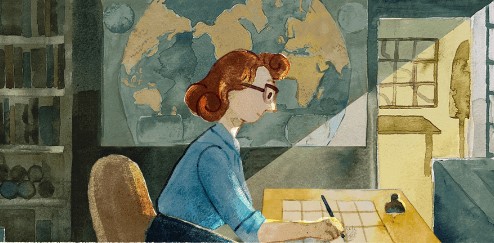Marie Tharp: Google doodle celebrates life of American geologist & oceanographic cartographer

- Country:
- United States
On November 21, 2022, Google doodles celebrate the life of Marie Tharp, the American geologist and oceanographic cartographer who helped prove the theories of continental drift. The doodle features an interactive exploration of Tharp’s life. Marie Tharp co-published the first world map of ocean floors.
On this day in 1998, the Library of Congress named Marie Tharp one of the greatest cartographers of the 20th century. In partnership with Bruce Heezen, she created the first scientific map of the Atlantic Ocean floor.
Today’s doodle artwork is created by Caitlyn Larsen, Rebecca Nesel, and Dr. Tiara Moore, three notable women who are currently living out Marie Tharp’s legacy by making strides in the traditionally male-dominated ocean science and geology spaces.
Marie Tharp was born on July 30, 1920, in Ypsilanti, Michigan. She was the only child of Bertha Louise Tharp, a German and Latin teacher, and William Edgar Tharp. Her father was a soil surveyor for the United States Department of Agriculture. She often accompanied her father on his fieldwork, which gave her an early introduction to mapmaking. Despite this, she had no interest in pursuing a career in fieldwork as during that time this was understood to be men's work.
Marie Tharp attended the University of Michigan for her master’s degree in petroleum geology—this was particularly impressive given so few women worked in science during this period. She moved to New York City in 1948 and became the first woman to work at the Lamont Geological Observatory where she met geologist Bruce Heezen.
Heezen gathered ocean-depth data in the Atlantic Ocean, which Marie Tharp used to create maps of the mysterious ocean floor. New findings from echo sounders (sonars used to find water depth) helped her discover the Mid-Atlantic Ridge. She brought these findings to Heezen, who infamously dismissed this as “girl talk”.
However, when they compared these V-shaped rifts with earthquake epicenter maps, Heezen could not ignore the facts. Plate tectonics and continental drift were no longer just theories—the seafloor was undoubtedly spreading. In 1957, Tharp and Heezen co-published the first map of the ocean floor in the North Atlantic. Twenty years later, National Geographic published the first world map of the entire ocean floor penned by Tharp and Heezen, titled “The World Ocean Floor.”
Tharp donated her entire map collection to the Library of Congress in 1995. On the 100th anniversary celebration of its Geography and Map Division, the Library of Congress named her one of the most important cartographers of the 20th century. In 2001, the same observatory where she started her career awarded her with its first annual Lamont-Doherty Heritage Award.
Sources: Google doodles, Wikipedia
Also Read: Virgínia Leone Bicudo: Google celebrates 112th birthday of Brazilian psychoanalyst










